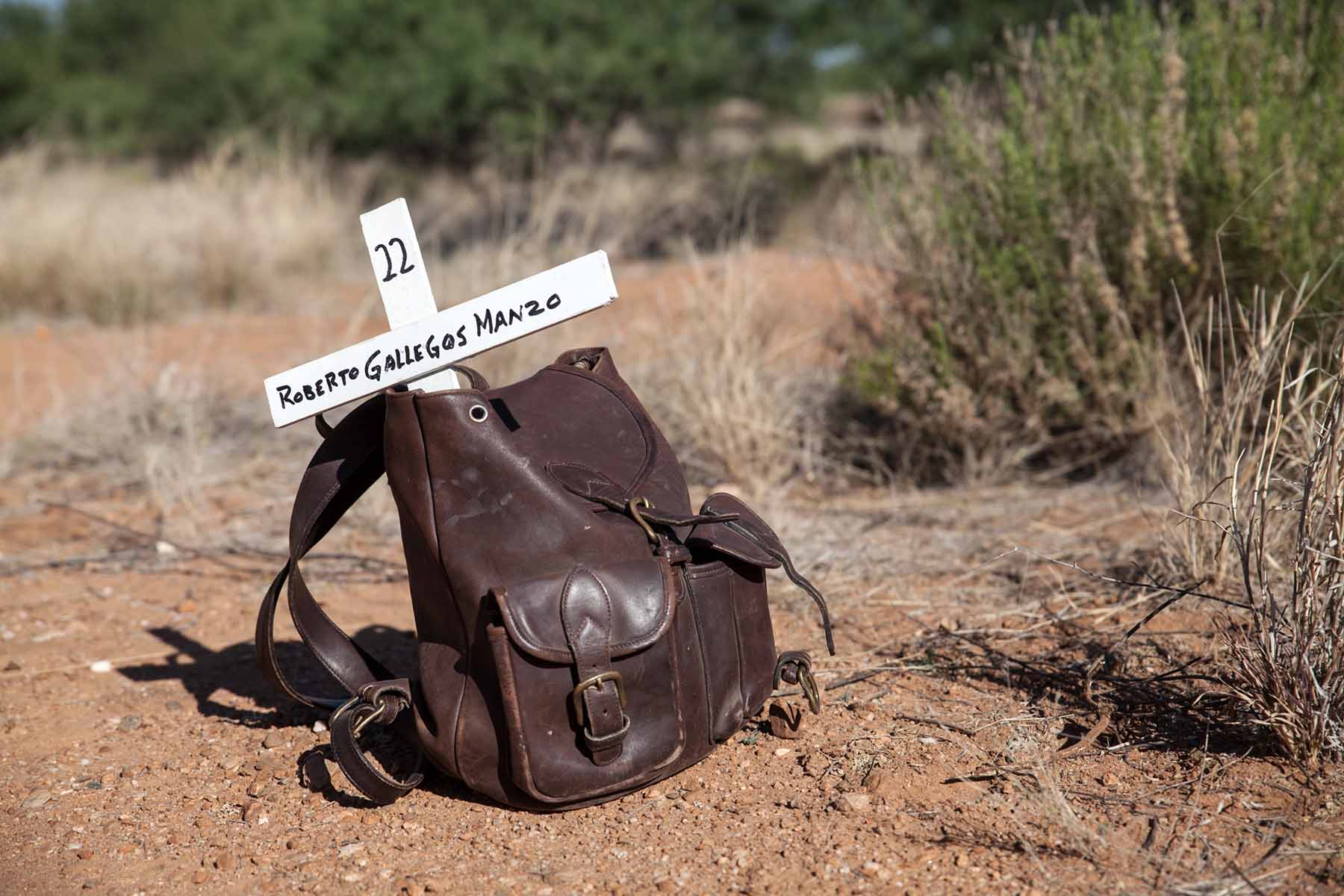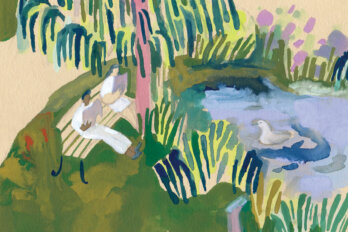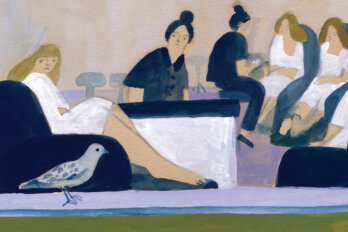Late last spring, I stood alongside the steel bollard panels of the US–Mexico border wall and thought about the dead.
I’d joined about thirty others who had driven down to the frontier from Tucson, Arizona, early that morning, then crossed into Sasabe, Mexico, on foot. In the shadow of the nine-metre-high barrier, an Indigenous Mayo woman named Maria Padilla smudged our group with burning sage and tobacco. Then she slowly unspooled a string knotted with 160 prayer ties. Each pinch of tobacco entwined in red cloth represented a set of migrant remains recovered from the Sonoran Desert in the past year, along with a blue tie to represent the sky, a yellow one for the sun, and a white for the bodies that haven’t yet been found.
Later, Padilla would tell me she had difficulty knotting the cloth on some of the tobacco bundles, as if they resisted being tied. This meant the person had struggled in their final moments, Padilla said. Their desert death was particularly hard.
Thousands of bodies have been recovered from the borderlands since the mid-’90s, when the American government launched a series of border policies many observers believe was designed to kill. The strategy gradually erected walls near large border communities like Sasabe, Nogales, and Douglas, where migrants who managed to cross could easily “assimilate with the population,” according to a 1994 document prepared by the US Border Patrol. Walling off the urban areas would funnel migrants into “remote, uninhabited expanses of land,” the plan said, where they could find themselves in “mortal danger.” The risk of death was to provide “prevention through deterrence” and discourage migrants from trying to cross in the first place.
The policy failed: the most desperate took their chances anyway. Some hired guides, referred to as “coyotes,” to lead them across. Others attempted the journey on their own. The unluckiest died, and the Sonoran Desert quickly became a migrant graveyard. According to the local medical examiner, many victims died of environmental exposure. Some, though, suffered more intimate violence. From 2000 up to the time of writing, 116 people were shot, strangled, stabbed, or beaten. Seventeen desperate souls hung themselves.
In 2004, a group of activists decided to respond to the rising body count by walking what they called the Migrant Trail. They plotted a week-long, 120-kilometre route through the Tucson sector, one of the busiest for crossings and the site of many migrant deaths. The idea was to bear witness to those who died on the border and to experience—in a small way—the same heat, dust, and exhaustion. The group promised to return every year until the deaths stopped. They never did. More than 3,000 bodies have been recovered since 2004, and the walkers keep walking.
Some walkers have personal connections to the border. Around 2017, one man walked in memory of his cousin’s son who died trying to reach it by train surfing. A Honduran American man once walked wearing the same shoes he’d worn crossing the desert seventeen years earlier. Most participants, though, have no such affiliations. Arriving from around the US, Canada, Mexico, and elsewhere, they gather to tread the same desert route from the Mexican frontier to Tucson. They don’t come to learn about the border, at least not formally. There are no lectures or speakers on the trail, just the ritual of constant forward motion. “The point is to shut up and walk,” said Kat Rodriguez, one of the organizers of the inaugural trail.
I wanted to know why the walkers came. So, when participants gathered for the twentieth Migrant Trail last spring, I joined them.
After the border wall ceremony, the trail began in earnest. We crossed back into the US and walked about seven and a half kilometres into the Buenos Aires National Wildlife Refuge to our first campsite. I laid my tarp and blanket on the red soil beneath a mesquite tree. Everyone went to sleep at dusk’s first blush. The desert chill roused me in the middle of the night. I hadn’t expected the nights to be this cold.
The walkers all awoke at dawn. We could see the border wall from the campsite. Up close, the surface of the fence is rust coloured and rough. But from a distance, and in the sunrise, it gleamed: a white shimmer that spanned the landscape, guarding north from south.
We had been divided into five teams, each responsible for specific tasks. The food team laid out breakfast each morning, put out snacks at stops, and assisted the donors who brought lunches and dinners. The health team, equipped with medical kits, tended to blisters, cactus thorns, and sunburns. The enviro team assembled and emptied bucket toilets. I volunteered for logistics. We’d handle everyone’s gear and set up the tarps and canopies for shade.
The walkers broke camp after breakfast. Then we started out. We moved in a tidy line, with the walker at the front carrying the spool of prayer ties from the border ceremony. Most of my fellow walkers were people of faith. There were progressive pastors and sisters and a grey-bearded Franciscan brother named David who’d walk the entire trail in his brown robes. Many had done the walk before—some a dozen or more times. Although rosaries hung around a few necks, or dangled from CamelBaks, and the group participated in a few blessings, the trail is not meant to be a faith-based experience.
Still, nearly every walker picked up a wooden cross to carry for the duration of the trail. The crosses, each festooned with paper flowers, represented the bodies of migrants found in the desert. Most of the crosses the walkers carried represented unidentified remains. These crosses bore the word “Desconocido,” the Spanish masculine term for “unknown,” if the body was male, and “Desconocida” if the remains were female. Some crosses read “Desconocido/a” when not enough remains were found to determine their sex at all.
Some crosses bore a migrant’s name and age. Among them was Victoria Méndez Carreto, a twenty-year-old Guatemalan woman. Méndez Carreto and her husband, Alexander Gómez, had left their home for a ten-day journey to the US–Mexico border. They’d hired a coyote to lead them across the desert. At some point in the journey, Méndez Carreto felt faint. The last message her father received from the couple during their journey came from Gómez, according to Guatemalan media network TN23. They’d spent three days without food or water. “Now we’re almost alone, us two, and we’re really tired,” Gómez wrote. “Victoria passed out, and her heart and soul hurt.” Gómez stayed with Méndez Carreto until she died, then sought help from the border patrol, effectively surrendering himself in the process. He led them to her remains—designated “fully-fleshed” in the parlance of the medical examiner. Both he and Méndez Carreto’s body were sent back to Guatemala the following month.
Later I’d learn that two more bodies were found in the shadow of Lesna Peak, not far from where we’d walk, on our first day on the trail. Two more prayer ties. Two more “Desconocido/a.”
Government agencies meticulously record death statistics and report the numbers on official websites. The media dutifully publishes stories about the crisis at the border and political efforts to stop the migrant influx. But what Rodriguez described as the “truth of the border” receives little attention. For twenty-three years, Rodriguez has worked and volunteered for organizations providing refuge and relief for migrants and asylum seekers in Arizona. She has collected belongings found alongside migrant remains to return to their families. She also spent time in the morgue, talking to bodies on behalf of heartbroken mothers who cannot reach them. These stories get erased. “It’s this empty space that we fill with walking,” she said.
Everything about the desert reminded me that the landscape can be a place of pain. The dried seed pods of the devil’s claw, whose curved spikes pierced our shoes. The cholla’s ferocious thorns. The night’s cold. The lashing wind and midday heat and the gaunt trees that offered little shelter from either. Even the delicate roadside flowers arm themselves with bristles. No wonder the shrubs of Adam’s needle raise a tall flag of white blossoms like a surrender.
Our days took on a routine. Each morning, we packed up our gear while the logistics team arranged everyone’s tents, sleeping bag rolls, folding chairs, and backpacks into a trailer which would be towed to our next campsite. A white-bearded man named Mike made coffee, which we drank from the plastic camping cups we’d brought with us. We smeared cream cheese or peanut butter on sliced bagels that toughened as the week progressed.
Members of the safety team wore reflective vests and communicated using radios to ensure we kept to a reasonable pace and to warn of approaching cars. The organizers generally divided the walk into individual segments between two and three kilometres in length. We walked in silence, our journey scored by the call of insects and the sound of our footfalls.
As we approached the end of every leg, each walker raised the cross they carried over their head and shouted the migrant’s name and “desconocido,” “desconocida,” or “desconocido/a.” In response, the rest of the group shouted “presente” to indicate that the spirit of that migrant accompanied us. We performed the “presente” call-and-response more than forty times during the week. The ritual never failed to shake me. I wondered what the migrants’ families would think of us proclaiming the names of their lost loved ones into the desert air.
The end of each leg alternated between water stops, where we’d fill our bottles from jugs placed on a trailer, and full stops, fifteen-minute breaks when we could slip off our shoes and sprawl on a tarp in the shade. Walkers tended to their blisters on these full stops and snacked on granola bars or watermelon slices the walkers dusted with Tajín, a Mexican spice blend.
If walkers needed a rest, they could ride in one of the support vehicles—white vans with bumper stickers like “Black Lives Matter,” “No Hablo Republican-o,” and “Love thy Neighbor (No Exceptions).” The leaders encouraged these breaks. The trail wasn’t meant to be an athletic ordeal, nor did we intend to simulate the experience of the migrants we walked in memory of. How could we? We had unlimited food and water and whatever medical attention we’d need. Vehicles carried our gear. We couldn’t get lost. No guides would abandon us if we slowed them down. The fear of death didn’t darken our week of walking.
But even if the trail could somehow mimic the physical challenges migrants face, our walk could never recreate their desperate motivations. My son’s future doesn’t depend on this journey. I’m not fleeing poverty or the guns of gangsters. I don’t question whether walking is worth the risk, because I risk nothing. I know I’ll return to my family at the end of the week. There are no stakes for me beyond sore legs, sunburn, and blisters. Instead, the trail is an opportunity for us to share the same air and landscape with people who gamble everything for a life in the United States—and often lose that bet.
We’d typically arrive at our campsite around noon. Instead of walking the final leg, the logistics team drove ahead to unload gear and canopies. Local church groups or humanitarian organizations brought our lunches and dinners—always vegetarian and more food than we could possibly eat. Volunteers with Humane Borders drove in a water tank to resupply our drinking water. Once our canisters were full, walkers lined up to take brief, full-clothed showers using the hose attached to the tank. Laughing and shivering, we thrust the nozzles under our T-shirts and down the back of our shorts and tried to wash hair so filthy our shampoo could scarcely lather.
Each night, pairs of walkers volunteered for two-hour safety shifts, keeping watch while everyone else slept. Those on watch were supposed to alert the leaders if anyone approached—migrant or otherwise. Nobody did, but the organizers had warned us about armed vigilantes in trucks who patrol the borderlands to “protect” the frontier from “illegals.” Veteran walkers remember one man with an AR-15 who stood near the roadside and hurled curses at the group as they walked past.
For the first three days, the trail followed a path through the refuge strewn with coyote scat and lined with mesquite trees. This is traditional land, home of the Tohono O’odham, whose name means “people of the desert.” During our entire time in the refuge, we walked in full view of their sacred Baboquivari Peak—the centre of the O’odham universe and dwelling place of I’itoi, their Creator.
But I’itoi wasn’t the only one potentially watching our progress through the landscape. While there is no way to know for certain how many migrants attempt to cross the border each year, the border patrol encountered more than 2.3 million migrants on the southwest land border in 2022 and more than 1.7 million the year before. And those numbers don’t include migrants who made it without being caught or those who died.
So we weren’t alone. “There are migrants walking near us,” Rodriguez told me. “They 100 percent know we are here.” Migrants typically want to remain out of sight, but trail walkers have encountered migrants several times before. Sometimes they just ask for water or food and carry on. One year, a lone migrant man approached one of the walkers at the back of the line. “I’m done,” he said. The desert had defeated him. “Can you call the border patrol?” Rodriguez sat with him for two hours before agents came to pick him up.
I found it strange to be silently observed by those in whose honour we walk but who don’t know we walk in their honour. They are just beyond our sight. Walking and hiding. Maybe dying.
We’d traverse nearly twenty-six kilometres on Thursday, our longest and hardest day. In order to finish before the sun began to scorch, we woke at 3:30 a.m. and packed up our campsites by headlamp. We walked through the last hours of darkness, cold and unfed, until the rising sun illuminated Baboquivari Peak, just as it did the border wall a few days before.
The walkers took breakfast in the parking lot at the exit of the refuge. Two purple porta potties waited for us on a flatbed trailer. The rousing applause these plastic booths received testified to how weary we all were of our orange Home Depot buckets. I can only imagine the relief felt by the enviro team, who could put their shovels away.
We started our single-file trek north along State Route 286. After spending days in the desert, many migrants emerge onto this highway just as we had and meet the pick-ups they’d arranged to bring them to friends, family members, or job sites further afield. Many discard their desert-crossing gear into the roadside ditches, and we spotted this jetsam as we walked past. Trousers and baseball caps made of identical blue-grey camouflage fabric. “Carpet shoes” made from scraps of rug that migrants slide over their shoes to conceal their footprints in the sand. I saw four-litre water jugs made of black plastic so they’re harder to spot by border patrol. Some bottles had a blue label with an image of Baboquivari Peak, so that if a migrant got lost, they could walk toward the mountain on their bottle and know they were headed north.
Occasionally, a green and white border patrol vehicle would speed by us, and we passed through a checkpoint they’d erected on the highway. In order to intercept border crossers, agents stopped vehicles and demanded to see passengers’ documents. They paid us little attention, though, greeting us with bemused smiles and waves. They knew who we were. “We always let the customs agents at the border know we are coming,” Rodriguez told me. Except for a few unpleasant run-ins over the years with the border patrol, she said—“dusting us, being aggressive”—the walkers had mostly been left alone by authorities.
Thursday’s long journey demanded a toll. My calloused feet proved immune to blisters, but they throbbed hot inside my shoes. Electric pain flashed from my hips down my legs every few steps. I hoped my fellow walkers, especially those on the medical team, didn’t see me wince or hear me whimper. I feared they’d insist I ride in a van for a leg or two. Instead, I gritted my teeth and popped ibuprofen like candy.
That night, I confessed to Rodriguez about my aching feet and hips. She’d had a rough day too, fighting a fever and a cough she couldn’t shake. “If we were real migrants, we’d be left behind,” she said. She told me about finding a dead cellphone in the desert a few years ago. Rodriguez charged the phone when she returned to Tucson and checked the messages. The final texts were from a migrant man to his mother:
Our guide left us.
We don’t have any water.
We’re lost.
When I asked a fellow participant named Alma Schlor why she walked the trail, she told me about the vultures.
About five years ago, Schlor was in the desert with another volunteer, leaving jugs of fresh water along known migrant routes. Some border patrol agents have been filmed emptying and destroying water supplies left for migrants, although the agency has stated that they do not condone this practice. Schlor and her companion pulled their car over to the side of the road when they saw vultures circling overhead. Beneath them, lying alone in the sand, was a man about to die. “Señora,” he called out to Schlor. “I want to see my children.”
Schlor sat with the dying man while her colleague went to get help. The vultures never left. “They were just waiting for him,” she said. Eventually, volunteers from another migrant activist group arrived to tend to the man. He survived.
“What was his name?” I asked Schlor.
“Alejandro,” she said, and I reflexively mouthed “presente.”
Most other walkers carried one white cross, which they attached to their backpacks. Schlor, though, carried four and held them all in her arms the entire journey. She told me she cradled the crosses to grant these migrants the dignity they’d been denied. She thinks about their souls as she walks: “I don’t know if you know I’m carrying you, but I hope this means a lot to you. To give you peace.”
“But why do you carry so many?” I asked her.
“I want to carry as many as I can.”
Saturday was our last full day on the trail. We marched eighteen and a half kilometres to what the walkers called “Hell Camp,” a Bureau of Land Management campground occupying an abandoned gravel quarry. Hell Camp had few trees and lacked sufficient shade. Heat throbbed upward from a bare patch of gravel and broken glass.
I spoke to Silverio Ontiveros, a retired police officer from Phoenix. He and his wife, Susan, have walked the trail at least nine times. He calls the walk a caminata—a long, hard journey. This might be his final caminata, however; he’s seventy now and saw how some of the older walkers had a difficult time.
When Ontiveros walked, he thought about the girl named on the cross he carried: Gurupreet Kaur. Over the past twenty years, only five migrant bodies found in the area were identified as coming from somewhere other than Middle or South America. Four of them came from India. Gurupreet was one of them. She was a six-year-old Sikh girl from a village near New Delhi. Her body was found in June 2019. Gurupreet and her mother planned to join her father, who, since 2013, had been living in New York, where he was seeking asylum. They crossed the border not far from where we walked. Gurupreet and her mother were separated when her mother went to search for water. Border patrol agents found the child’s body the next day. She died of heat stroke. Alone. “I walk for her,” Ontiveros told me.
Working with churches and migrant organizations, Silverio and Susan help feed and clothe asylum seekers and provide transportation to the airports so they can catch flights to their sponsors. They also teach free citizenship classes to permanent residents. Walking the trail inspires this day-to-day activism. “It just re-energizes us,” he said. “Especially when you see people not only from this country but your country—and people from New York, people from Iowa, people from Oregon and Colorado. And the different religions or non-religious people. It’s amazing the power they have. And it moves me to say, ‘I haven’t done enough.’”
A short walk up the side of the quarry led to a viewpoint that encompassed all the landscape we’d come from. We could see Baboquivari Peak from here, and Kitt Peak, and the space between the mountains we’d travelled through. We held a final ceremony here just after sunrise the next morning. An Indigenous woman named Susan burned creosote leaves in a shell and wafted the smoke over each walker with an eagle feather. Another man, Kevin, assured us that our efforts as “two-leggeds” made our Creator proud. Susan and Kevin played a song on frame drums. Afterward, we moved around the circle and embraced each of our fellow walkers in a gesture of gratitude and farewell. I’m neither a believer nor much of a hugger, but the ritual coaxed tears from me.
We walked just shy of eleven kilometres that final day. A cinch. We approached Tucson along a busy highway, stepping over trash on the shoulder as vehicles sped by. Occasionally, a driver would honk their support. A small reception awaited us in Kennedy Park, where the walk finally finished. Volunteers from a local church symbolically washed our feet. We shared one last lunch together. One last unloading of gear. A last informal goodbye.
Then, suddenly, there was nothing to do. My body took three days to concede I had no more kilometres left to walk and continued to awake at dawn. On those too-early mornings, legs still aching, I thought about what the trail means and doesn’t mean. The trail does not stop the deaths, but I didn’t need to walk for a week to know this. The trail might be an act of solidarity, but vanishingly few of the millions of border crossers we walk for even know we exist. The trail receives scant public attention and raises little awareness. It seemed a personal ordeal, more a pilgrimage than a protest. At times, it was an intimate communion between the walker and the ferocious beauty of the desert. Between the walker and the memory of the migrants who had passed through—and the migrants who had passed away. Between the walker and their own body. Each ache and blister an offering. Every footstep a promise.






